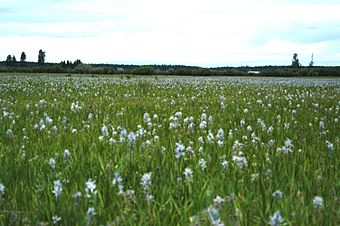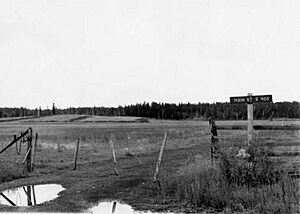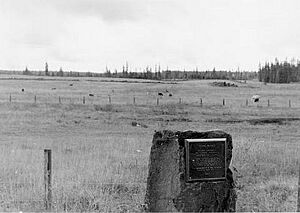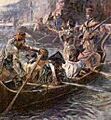Weippe Prairie facts for kids
|
Weippe Prairie
|
|

Camas flower field, Weippe Prairie, Idaho
|
|
| Lua error in Module:Location_map at line 420: attempt to index field 'wikibase' (a nil value). | |
| Nearest city | Weippe, Idaho |
|---|---|
| Built | 1805 |
| NRHP reference No. | 66000311 |
Quick facts for kids Significant dates |
|
| Added to NRHP | October 15, 1966 |
| Designated NHL | May 23, 1966 |
Weippe Prairie is a large, open field in Clearwater County, Idaho. It's about nine miles wide and twenty miles long. Pine forests surround this beautiful area, which sits at 3,000 feet above sea level.
Special flowers called camas grow here. The roots of these flowers were an important food source. Native American tribes, especially the Nez Perce, came here to gather them.
Weippe Prairie is famous because it's where the Lewis and Clark Expedition first met the Nez Perce people. This meeting happened after Lewis and Clark crossed the tough Bitterroot Mountains. Today, this historic field is part of the Nez Perce National Historical Park.
Lewis and Clark Meet the Nez Perce
On September 20, 1805, the first members of the Lewis and Clark Expedition arrived at Weippe Prairie. They were very hungry and tired from their long journey. Here, they met the Nez Perce tribe. The Nez Perce were in the area to hunt and gather camas roots.
The Nez Perce people had never seen white explorers before. They were very helpful to Lewis and Clark. By September 22, 1805, the whole expedition had reached the prairie. Lewis and Clark met with several Nez Perce chiefs. One chief, Red Bear, gave them buckskin clothes. Lewis and Clark gave them beads and other small gifts in return.
A Friendly Welcome
The Nez Perce were friendly to the explorers because of a special story. A young woman from their tribe, named Watkuweis, had been taken away and sold into slavery. She eventually lived with white people and then returned to her tribe.
When Watkuweis heard about Lewis and Clark's arrival, she asked her people not to harm them. She shared stories about the kindness she had received from white people. Her stories helped convince the Nez Perce to welcome the explorers as friends.
The Nez Perce gave Lewis and Clark camas root cakes and other food. They also helped them build canoes to continue their journey west. The tribe even drew maps of the water routes for the expedition. When Lewis and Clark returned in 1806, they found their hidden supplies untouched. They also got most of their horses back. The expedition stayed with the Nez Perce from May to late June 1806. This was because the snow in the Bitterroot Mountains melted late that year.
Weippe Prairie Today
The part of Weippe Prairie most connected to the Lewis and Clark expedition is now a special place. It was named a National Historic Landmark in 1966. This area is covered with camas flowers and is near the town of Weippe, Idaho.
Weippe Prairie is one of 38 sites that make up the Nez Perce National Historical Park. This park helps tell the story of the Nez Perce people. The name "Weippe" is pronounced WEE-ipe. It comes from a Nez Perce word. Its meaning might be "a very old place" or refer to a spring or the camas fields.
This historic landmark is also important to the 1877 Nez Perce War. After the Clearwater Battle, the Nez Perce bands who had not signed treaties held a meeting on this prairie.
Images for kids









